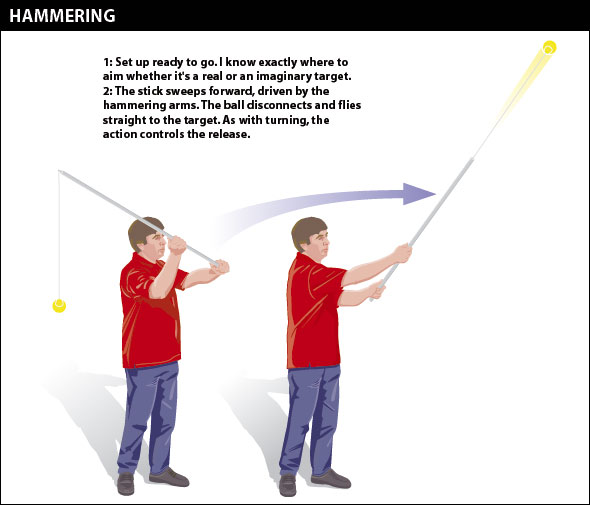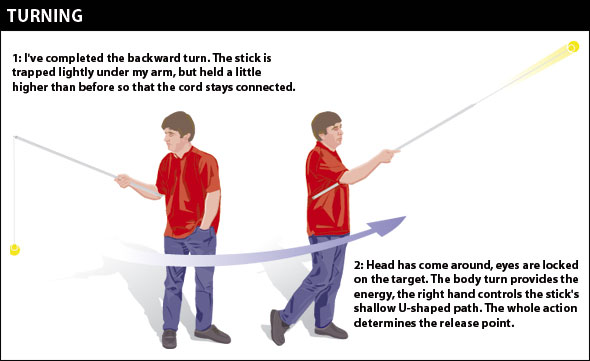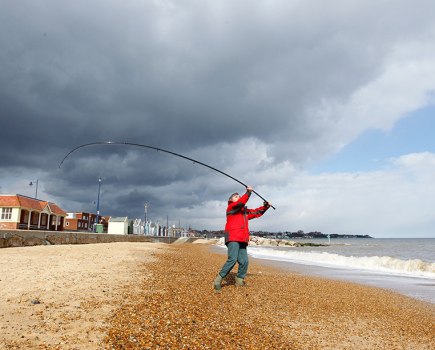So you want to be a competent caster? The first thing you need is a broomstick with a nail in the end, and a piece of string with a tennis ball hanging off the end. Sounds crazy? Not if you want to learn how to cast baits to the fish, says casting guru John Holden
THE SIMPLE, natural arm and body actions of Turn and Hammer exercises contain the key movements from which every good casting style is assembled. They generate the powerful engine and smooth transmission that underpin big pendulum swings and relaxed ground casts alike.
Efficient casts are built from common components even though the ‘shapes’ of the various casting styles vary. At the moment we must concentrate on building the mechanical foundations that are the secret of success.

TENNIS BALL THROWING
For this you need a stick about four feet long, a piece of strong cord and a tennis ball. A broom stick is ideal. Drive a headless nail into one end to form a spike about two inches long.
Now tie a loop in one end of the cord and a tennis ball to the other. The ball should hang about two feet below the loop.
If it doesn’t feel right or release cleanly, adjust it up or down a little.
Now re-run last month’s Turn and Hammer exercises. The only change is that the stick and ball replace the lightweight hammer. The hammering action is exactly the same; the idea is to play around and see what happens. This is not casting, remember.
A target is essential. You can fix a real one to an outside wall and aim at that. Better still, imagine a target in mid-air. Play around with different target heights and directions. High and low. Left and right. Alter your stance from closed to square to open in relation to the target.
Focus on the target – begin just above eye level and a little to the right – and flip the ball towards it. First attempts will be wayward. Don’t worry. Hammer away smoothly and stay focused on the target.
Relax and let it happen – soon the ball will be hitting the mark most of the time. This is your body’s subconscious self-correcting process at work.

SEE AND FEEL WHAT CHANGES
But these exercises are not really about distance and power. Trying to hurl the ball further and further does more harm than good. It will be far more valuable to see and feel what changes occur in the ball’s flight path as you experiment with different ways of turning and hammering.
Lessons learned here help define the correct framework and mechanics for proper casting.
They also show which variations on the turn and hammer themes happen to suit you best – such a stance, target position, arm action and weight transfer.
Try hammering with the arms a) in unison – the natural hammering action, b) left hand dominant and c) right hand dominant. Use varying amounts of body turn. Shift the target around. Wherever it is, aim straight at it.
See how the ball’s flight path varies according to the changes you make. Feel that some set-ups are comfortable, others cramped, powerful or weak.
Notice that the ball’s release point is always automatic but alters in step with the changes you make to hammering, turning and target position. Left to its own devices – which it should be – release always occurs according to the laws of physics.
TAKING THE RIGHT TURN
TURNING calls for a slight alteration: as you coil into the backward turn, lift the end of the stick a couple of feet so that the cord remains looped on the nail. Then as you turn forward, add a little bit of arm action – down then up – to sweep the ball through a shallow U-shaped arc. Power comes from the body turn; the arm does no more than guide the stick and ball.
Rather than think about technique, turn smoothly away from the target. As you turn, imagine your body coiling like a spring. As you swing forward, concentrate on feeling the ball release. Coil and release. Backwards then forwards. Feel the ball escape and fly towards the target. As with hammering, let accuracy develop in its own good time.
Run both exercises with as many variations as you can think of. See and feel what happens. These are not exams, so there is no right and wrong. No good and bad. The objective is to learn about your body’s natural power and control systems.
Hammering will certainly show you how a simple arm action can send the ball a long way. Were you to repeat both this and the turning exercise with a 5oz sinker, you might be surprised to find that an effortless flick achieves 75 yards or more.
Please be careful if you do switch to a lead weight. You need a lot of safe space in front and to the left and right.
The turning exercise should be especially impressive if you have not been aware of the importance of body action in good casting. How can such a simple, easy swing produce so much power?
TURN-AND-HAMMER COMBINED
YOU MIGHT recall that earlier in the series, I pointed out the tendency to become over-analytical about casting techniques. Avoid falling into that trap here. All we’re doing is blending the simple, natural Turn and Hammer actions into an equally simple, natural mixture. There are no hidden extras.
Pick up your lightweight hammer and set yourself up ready for the Turning exercise. Identify the target and turn away from it to produce the spring-like body rotation.
Instead of tucking the hammer under your right arm, hold it in both hands and extend it back a little as I’m doing in the first illustration. Note that both arms are held relatively straight and comfortably away from the chest.
This is an important technical point that we shall be looking at in the next issue when I show you how to generate and control plenty of casting power with little apparent effort.
Think: Where is that target? Begin uncoiling on the forward turn, keeping your arms relaxed in front of your chest. Get your head around and focus on the target, exactly as before. Keep turning, and when it feels right, hammer the target. Let me repeat that: when it feels right.
Avoid measuring off a certain arc of body turn before the hammering begins. Don’t try to work out how your arms move from in front of your chest into the ready-to-hammer position. Just let it happen.
Think Turn… and Hammer. Notice the timing. One… and two. Not one, two. Stay focused on the target. Like the separate turning and hammering actions, the combined flow is a natural, simple action.
Play around with the exercise, dialling in the familiar variations of left and right hand emphasis, different stance, and shifting the target. Now you can add high and flat rod arcs as your body uncoils – from side-swipe to over-the-top.
And yes, this is a proper casting action at last. It is actually a pretty good one. By all means try it with rod and reel, but don’t get serious. Mess around instead. Feel what happens to your body and tackle when you make the moves, good and bad. Every rod gives important feedback about what’s going on. Few casters ever get the message.

STAY SWITCHED ON
It is important to underline the issue of release timing which these exercises illustrate so clearly.
A successful caster must be wideawake to what’s happening beneath the surface of his technique. He needs to develop and tune his method and tackle to allow for the fact that sinkers, like tennis balls, have a mind of their own about precisely when to escape skyward.
To get the best from any cast – distance, control, accuracy – it is vital that arm and body actions, rod loading and reel response are synchronised to trigger an automatic sinker release at the point in the casting arc which puts the sinker on the right flight path.
Trying to control a cast, by hanging on too long or letting go too soon, is a serious but common mistake.
Damage includes loss of distance, burned thumb, leader knot catching in the rings. Strong leaders snap like cotton. Heavy sinkers are impossible to cast.
Big trouble lies in store for the caster who tries to release the sinker by deliberately timing the letting-go point. The correct method here is to pre-programme the cast for automatic control.
Do that, and the cast will tell you – by feedback and feel – exactly when to let go. Then the letting-go process rapidly becomes subconsciously automatic as well. The good caster never gives it a second thought.
Pre-setting the release not only maximises power and control. The sinker’s flight path then becomes a diagnostic tool, pinpointing the areas to look at when things go wrong.
For example, a low, left pendulum cast suggests a lazy left hand or incomplete body turn, the two often going together.







